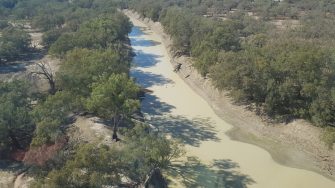
Date: Tuesday, October 15, 2019
Project: Eastern Australian Waterbird Survey
Observer: Richard Kingsford & Peter Ewin
Pilot: Tim Dugan
We loaded the plane up before dawn in Broken Hill to make sure we got going when it was cool and smooth. We headed north to about half way between Broken Hill and Tibooburra and then headed directly east. The first hour was spent checking to see if there was a skerrick of water along the survey band (Band 5). About once every decade, scattered lakes fill up here when there is good local rain and provide excellent habitat for waterbirds – not today.
Afterwards, there was only the odd farm dam, very shallow and seldom with any waterbirds.
As we headed east, we eventually got to Lake Mullawoolka, one of the Paroo River overflow lakes east of White Cliffs, which was about half full. There were not many more than a few hundred waterbirds on the lake, including black duck, grey teal and pink-eared duck, as well as a few pelicans. It must have filled from local flooding because it was dry last year and the Paroo hasn’t flooded. I have been surveying this lake for more than 30 years and was a bit surprised to see so few waterbirds on a reasonably large area of water at this very dry time.
The rest of the massive Paroo River floodplain, an amazing network of channels and swamps, was dry. Then on to the Darling River – south of Bourke, near Louth. The Darling River looked a miserable river, extended dry areas and a few waterholes with water in between.
Sure the river used to dry up occasionally but it was clear from the analysis done in the Academy of Science Report on the fish kills, that this is a river getting drier because we are taking too much water out of it.
After refuelling at Bourke, we headed across the Bogan River, surveying the odd farm dam along the way. Many of them had one or two grey teal or the odd white-faced heron. We eventually reached a very dry Macquarie Marshes. We started our survey at the ‘bottom’ of our survey band, which starts about two thirds up into the most northern part of the Macquarie Marshes. We swept back and forth looking for a creek or swamp with water – nothing. No water means no waterbirds. Eventually we found a small bore drain with four waterbirds, a couple of masked lapwings and stilts. Only once during the Millennium Drought have I seen it this bad. It didn’t get any better as we headed east. Dry river beds and dams everywhere. Occasionally there was a farm dam with some water and there were a few waterbirds. Around Narrabri, there was a lake which I have never seen without water – bone dry. The Namoi which almost always carries some water was just a string of puddles.
Massive Split Rock Dam further east, one of the two major dams on the Namoi, was almost dry. This dam, built in the 1980s, with a capacity about three quarters of Sydney Harbour, last filled in 2013.
Neighbouring Keepit Dam, with a little more capacity, was nearly full in late 2016. This is the river catchment where the Australian Government has promised $480 million to boost enlargement of Dungowan Dam to secure the water supply to Tamworth. The captured water in an enlarged dam will degrade rivers downstream, including the Darling River where the Namoi River eventually flows. There are many questions about these long term impacts and why another solution could not be considered, including piping water from the already large dams in the catchment. Split Rock Dam doesn’t even seem to fill in most years. Building more and bigger dams does not necessarily mean more water will be captured.
We finished off the survey along this survey band near Armidale, where again there was very little water with many farm dams dry or almost dry. Then we headed south to finish off the edge of Survey Band 4, around Lake Liddel, the controversial old power station.
It has dams where water is diverted from the Hunter to cool the coal-fired power station. Even these dams were low which was a surprise. But one had hundreds of coot and black swans. I could see the vegetation growing on the floor of the lake, which is why they were there. There were also some great-crested grebes on the lake.
We then surveyed a small section of the Hunter River which although low, had some water, but as usual only had the odd black duck and white-faced heron. We finished the survey back in Sydney.
